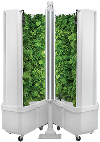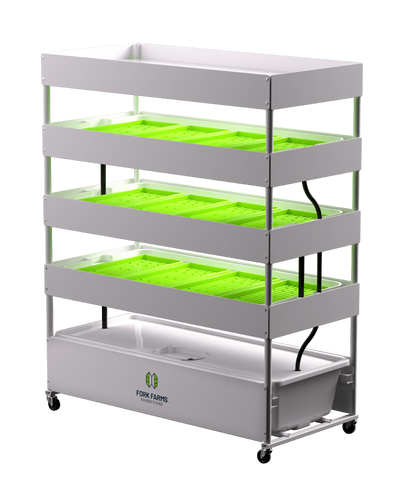The Different Ways an Indoor Hydroponic Garden Can Engage Students In The Classroom
Hydroponics, or the practice of growing plants using nutrient-rich water instead of soil, continues to reshape how our society approaches fresh food production and delivery. Every day, people across all walks of life are discovering its myriad of advantages over traditional farming–faster growth, higher yields, cleaner and healthier crops, better resource management, year-round harvests, etc.
And nowhere is this more evident than in our schools, where teachers have found that engaging students through hydroponic gardening provides a unique and innovative way to inform and inspire young people. By incorporating this method into classroom activities, students can learn about plant growth, sustainability, and environmental science while making use of their creativity, teamwork, problem-solving skills, and more.
Hydroponics: A Modern Alternative to the Outdoor Classroom Garden
Nationwide, one of the trends we’re seeing is teachers moving further away from traditional “sit and get” techniques in favor of more interactive, engaging, and hands-on learning that better corresponds with how students today consume and retain information. In partnership, many schools are adjusting their curricula accordingly.
As noted, one activity that has gained popularity as a progressive and innovative way to educate students is hydroponic gardening. For all its practical benefits outside the classroom, hydroponics is now recognized as a highly immersive, collaborative, and multifaceted activity that aligns with the changing needs–and attention spans–of modern students.
Plus, with a focus on sustainability, environmental awareness, and STEM (Science, Technology, Engineering, and Mathematics) education, hydroponic gardening programs in schools offer a unique opportunity to meet students where they are both academically and developmentally. Young people from K-12 are not only gaining a deeper understanding of science and biology, they’re also discovering the benefits of health and wellness, building essential life skills, and learning how classroom education can have “real world” applications.
Let’s take a closer look at hydroponic gardening, and how this modern method of cultivation is engaging and benefiting students across all age levels.
Hydroponic Systems
Hydroponic gardening is like traditional gardening but without the use of soil. Instead, plants grow in a water-based solution enriched with nutrients. This nutrient-rich solution is absorbed directly through their roots, allowing for highly efficient and controlled plant growth that often produces healthier fruits, vegetables, and herbs, along with more bountiful harvests.
There are several different types of hydroponic systems, each with its unique characteristics. For example, in a Deep Water Culture (DWC) system, plants are suspended in a nutrient-rich water solution with their roots submerged. Then, air stones or diffusers provide oxygen to the roots. In a Nutrient Film Technique (NFT) system, a thin film of nutrient solution is released over the roots of the plants. The excess solution is then collected and recirculated. And in Drip Systems, a timer-controlled pump delivers a nutrient solution to the plants using drip emitters.
Students & Their Hydroponic Gardens
Biology and Science Lessons
Regardless of the system, hydroponic gardening allows students to observe and understand the growth process of plants in real-time. With hydroponics, students can easily monitor the progress of their plants and make adjustments to the nutrient levels and growing conditions as needed. This helps students develop a better understanding of how plants grow and thrive in different environments.
What’s more, incorporating hydroponic gardening into their science curriculum helps students to learn about the scientific principles behind it, like nutrient uptake and plant growth. By connecting this hands-on experience to their science lessons, students are more likely to retain the information and develop a deeper understanding of–and interest in–the topic.
Critical Thinking and Problem Solving
Operating a hydroponic garden also encourages students to think critically and problem-solve. Tasked with carefully monitoring nutrient levels, pH balance, and water quality, students must analyze data, record their observations, and make informed decisions in order to optimize the growing conditions for their plants.
In addition to developing critical thinking skills, hydroponic gardening fosters creativity and innovation in students. By experimenting with different nutrient solutions, lighting conditions, and growing mediums, students can test out new ideas and techniques in order to maximize their plants’ growth. This process of trial and error encourages students to think outside the box and develop more creative solutions in their hydroponic gardens.
Math and Business Skills
Yet another way educators are engaging students through hydroponics is by incorporating interdisciplinary lessons. For example, they can tie in math lessons by having students calculate the growth rate of their plants or measure nutrient levels in the water. Similarly, a business or accounting class project could involve keeping the books–or calculating ROI–for a hydroponic system used in a commercial or for-profit enterprise. By integrating multiple subjects into the gardening experience, students are able to see the real-world applications of their learning.
Teamwork and Working Toward A Goal
Hydroponic gardening also helps keep students engaged by fostering collaboration and teamwork. Students can work together to care for their garden, brainstorm solutions when issues arise, and celebrate their successes as a team. This not only promotes positive social skills but also helps students develop a sense of community and belonging within the classroom.
Sustainable Agriculture, Community & The Environment
Moreover, hydroponic gardening provides students with a practical understanding of sustainable agriculture and environmental conservation. By growing plants in a water-efficient, soil-less environment, students are able to witness firsthand the benefits of sustainable agricultural practices. Teachers can further connect the hydroponic garden to relevant real-world issues, such as food security and resource management, and motivate students to make a positive impact on their community and the environment.
The Path Ahead For Indoor Classroom Gardens
Engaging students through hydroponic gardening is proving to be a valuable educational experience that can help young people develop a deeper appreciation for science, sustainability, and environmental stewardship. By incorporating hands-on activities, lessons on plant biology, and discussions on real-world issues, teachers can spark students' curiosity and encourage them to explore their role in creating a more sustainable future.
To learn more about how hydroponic gardening can inspire and engage students in your own school, reach out to a Fork Farms team member today. Our experts are happy to answer any questions, and if you’re ready, will help you select a system and develop a program that’s ideal for your individual needs.
Important Links:
























